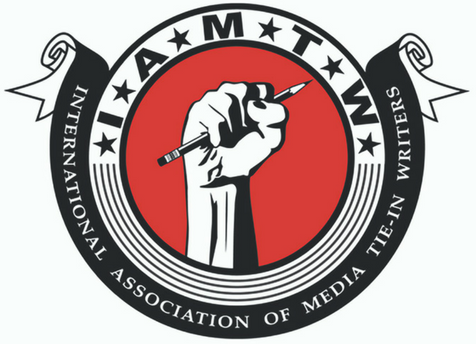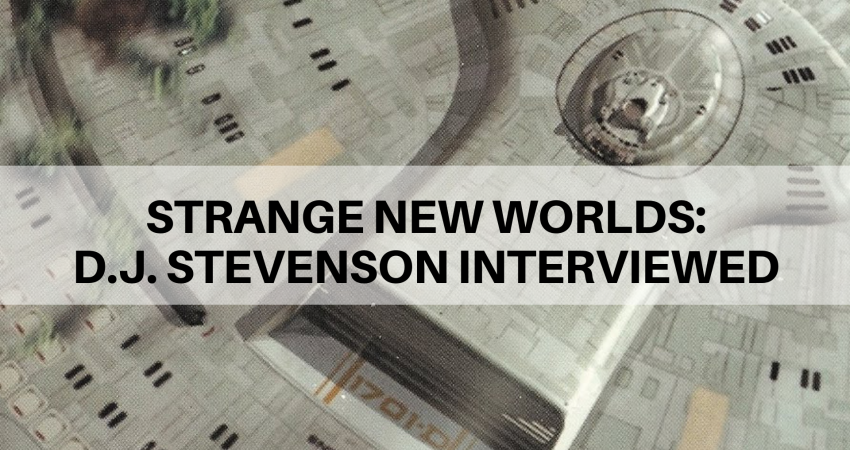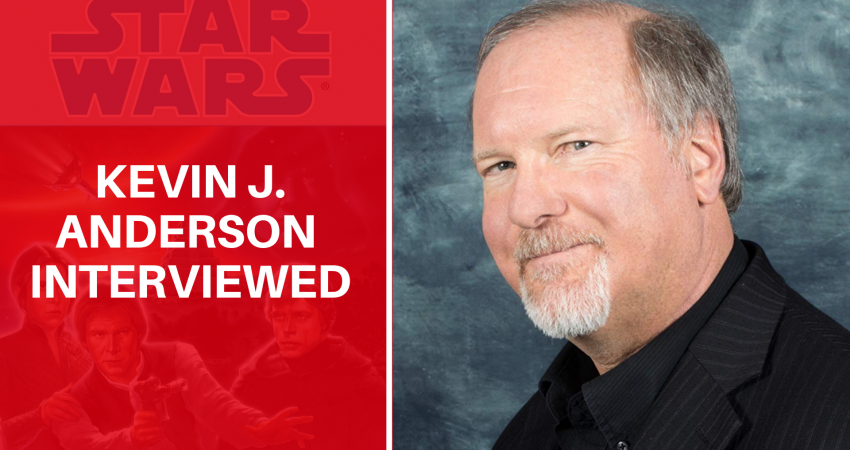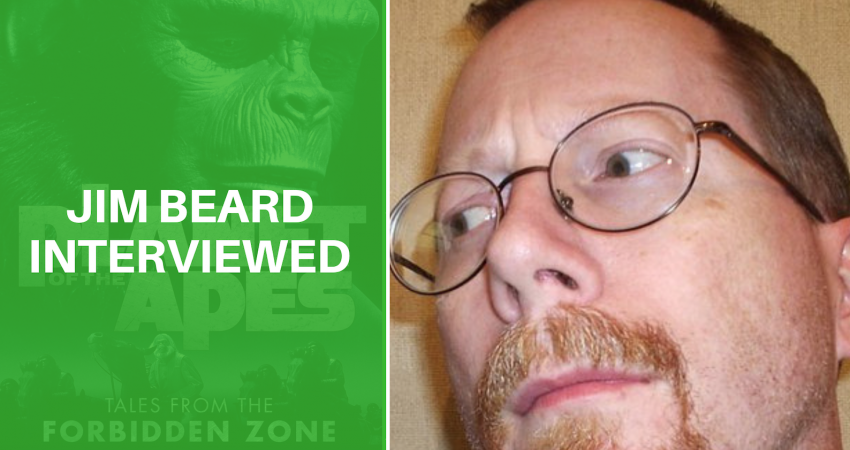 IAMTW President Jonathan Maberry chats with author Chris A. Jackson.
IAMTW President Jonathan Maberry chats with author Chris A. Jackson.
TIED-IN: What was the first media tie-in work you remember reading?
CHRIS A. JACKSON: The 1976 Star Wars novel, ghost-written by Alan Dean Foster. This book was kind of a turning point in my life, as was the movie. I discovered a whole world of SF and Fantasy after this, and promptly got into gaming (Dungeons & Dragons, Top Secret, Gamma World, Star Frontiers, and Traveller to begin with). I ravaged my school library for anything SFF, devoured Niven, Heinlein, Foster, Pournelle, then started spending my hard-earned money in bookstores. I believe George Lucas—and through him Alan Dean Foster—were the J.K. Rowlings of my generation. They got us reading
Did you ever write fan fiction?
Not really, although my first attempt at a novel-length work was a Dungeons & Dragons story pitched to TSR (rejected, and rightfully so, but I didn’t know then what I know now about writing tie-in for games). I read some fan fiction, but I’ve never written anything media related just to post online for my friends to read. I wrote a lot of original fantasy and SF to post on critique and comment sites like Elfwood (yes, I’m that old), but never anything connected to an existing IP. Writing tie-in, for me, is a commercial enterprise, and always has been. Call me whatever you like, but I write for a living. Fan Fic doesn’t pay the bills. Writing is my day job. Don’t get me wrong, I love what I do, but I have spent far too many years hacking out a niche for myself in this business (writing in general, not just tie-in) to do it for self-satisfaction alone.
What was your first media tie-in gig, and how did you get the job?
My first media tie-in work was for Paizo Publishing, in their Pathfinder RPG. I was attending my very first GenCon in Indianapolis, the largest gaming-focused convention in the US. Paizo was a sponsor, and I had learned a bit of the business by then, with seven novels under my belt and some national awards for my nautical fantasy series, the Scimitar Seas novels. I’d attended the convention at the suggestion of two people I’d met through that series—my editor at Dragon Moon Press, Gabrielle Harbowy, and Ed Greenwood, the creator of the D&D world of The Forgotten Realms.
I’d done my research on Paizo, had played their Pathfinder game for years, and knew exactly who to talk to. I approached their fiction editor, James Sutter, after the panel on “Writing for Paizo,” knowing that they had begun a line of Pathfinder Tales novels. I introduced myself, told him I’d just finished a four-book series of nautical fantasy, that I loved Pathfinder, their world, and the Pathfinder Tales line, but that—with all the open sea on their map, and their recent pirate-oriented “Skull and Shackles” adventure path, which was very popular—they had no writers giving them pirate stories. I could provide that.
 James told me to send him a writing sample, and I did. Six months later—I think when James was doing an end-of- year cleansing of his email in-box—I got a note asking if I could write some web fiction for Paizo. The pay was minimal, but this was a testing ground to see how fans liked my work. Interestingly, that story, “Stargazer,” didn’t get published on the site until my first novel was already finished and in final edits. I gave James the story in a week (8000 words), and it was as clean and polished as my wife and I could make it. He was impressed at how quickly and well I wrote, and then lightning struck. One of his novelists fell out of the publication schedule. James told me if I could give him a novel in five months, I could have that slot. I said “Hell yes!” and proceeded to write the rough draft of Pirate’s Honorin twenty-nine days. Then, of course, it took three months to edit it.
James told me to send him a writing sample, and I did. Six months later—I think when James was doing an end-of- year cleansing of his email in-box—I got a note asking if I could write some web fiction for Paizo. The pay was minimal, but this was a testing ground to see how fans liked my work. Interestingly, that story, “Stargazer,” didn’t get published on the site until my first novel was already finished and in final edits. I gave James the story in a week (8000 words), and it was as clean and polished as my wife and I could make it. He was impressed at how quickly and well I wrote, and then lightning struck. One of his novelists fell out of the publication schedule. James told me if I could give him a novel in five months, I could have that slot. I said “Hell yes!” and proceeded to write the rough draft of Pirate’s Honorin twenty-nine days. Then, of course, it took three months to edit it.
Talk about your experience working with that license.
I had a wonderful time working with James Sutter and Wes Schneider (the dynamic duo of editing at Paizo). James and I found that we saw eye-to-eye on many things, and I was given a lot of creative license, free to create my own characters, and play in their amazing sandbox world as much as I liked—as long as I didn’t break any of the toys. I’ve written five novels for Paizo, and although the two most recent are orphaned (I’ve been paid my advance, of course), the three that were published received solidly good reviews and I built a good fan following. I’m very sad to see the Pathfinder Tales line end, but Paizo just couldn’t get it to pay for itself. They are a great marketer of games, but there were some roadblocks initially to certain distribution channels. There were thirty-six published novels in the line, and most of them got very good reviews, but reviews don’t pay the bills. I’m afraid the two novels I have orphaned there will never see the light of day, but this is one business where you must look forward, not back. My overall experience with Paizo was wonderful. I wish it could have continued.
What kind of creative risks have you taken with your media tie-in projects?
 I didn’t really see this as a risk, but the one thing that stands out in my writing (novels, at least) is the inclusion of romantic elements in almost every story. I’m a firm believer that people, real people—and I am a creator of real people—even though they live in a fantasy world, tend to get laid occasionally. Love is a human emotion, and romance is a broad swath of human experience. If you don’t include that in your stories, you are ignoring a huge part of what it is to be human. My very first tie-in novel, Pirate’s Honor, I created a romantic environment; the two primary characters were a couple at the beginning of the story. The plot of the story had nothing to do with their relationship, but the stresses of their struggles put serious strain on the relationship, including trust issues and an addiction problem. I tend to write flawed characters, because nobody’s perfect, right? There was some minor push back, with the notion that “gamers don’t like kissing books,” but I pretty much proved that wrong. The feedback was about 95% positive, largely due to the strong female co-protagonist that I had created. I went even farther with my second Pathfinder Tales novel, Pirate’s Promise, with a same-sex tortured romantic relationship. The fans loved it.
I didn’t really see this as a risk, but the one thing that stands out in my writing (novels, at least) is the inclusion of romantic elements in almost every story. I’m a firm believer that people, real people—and I am a creator of real people—even though they live in a fantasy world, tend to get laid occasionally. Love is a human emotion, and romance is a broad swath of human experience. If you don’t include that in your stories, you are ignoring a huge part of what it is to be human. My very first tie-in novel, Pirate’s Honor, I created a romantic environment; the two primary characters were a couple at the beginning of the story. The plot of the story had nothing to do with their relationship, but the stresses of their struggles put serious strain on the relationship, including trust issues and an addiction problem. I tend to write flawed characters, because nobody’s perfect, right? There was some minor push back, with the notion that “gamers don’t like kissing books,” but I pretty much proved that wrong. The feedback was about 95% positive, largely due to the strong female co-protagonist that I had created. I went even farther with my second Pathfinder Tales novel, Pirate’s Promise, with a same-sex tortured romantic relationship. The fans loved it.
Of the media tie-in work you’ve done, what are you most proud of?
That is a tough call. I’m pretty proud of all my tie-in stories, primarily because I take pride in giving the publisher what they want. Of all my work, however, I think the Paizo novel, Pirate’s Promise, is my best. It’s filled with intrigue, deception, love, loss, action, subterfuge, and redemption. I went farther down into the dark side of people’s souls than I’d ever gone before, and it worked beautifully. There were three POV protagonists, which is pushing it for a tie-in novel, but it allowed me to move the story at a fast pace, and pull off some daring rescues. It was the perfect mix of action, suspense, romance, and the game elements that the fans love.
So, which media tie-in project was way outside of your normal style?
 One of my most recent works, The Deep Gate, for Fantasy Flight Games’ Arkham Horror property, was my first delve into the horror genre.
One of my most recent works, The Deep Gate, for Fantasy Flight Games’ Arkham Horror property, was my first delve into the horror genre.
The primary difference I found in writing Horror versus SF or fantasy is pacing. I relied on the input of my wife for that, as she reads much more horror than I do, and I got some great input from my editor Katrina Ostrander. The ramping up of the tension was gradual, and the slow suspension of disbelief of the protagonist working well. The hero, Silas Marsh, however is a cursed soul in the Lovecraftian sense, and was difficult to get right. I don’t usually create delusional characters, so it was a stretch. Good editing brought it through.
What are you writing now?
Actually, my latest tie-in gig came right through IAMTW! Thanks, guys! One of our members is not only a tie-in writer himself, but is an editor for Mongoose Publishing, a British game publisher. They’re doing a reboot of the great old SF RPG, Traveller, and the editor, Matthew Sprange, asked the group for anyone familiar with the game who was interested in writing a short story tie-in. I played Traveller a lot back in my college days, and jumped at the chance. I’ve since written four stories for Mongoose and I’m delighted with the experience!
What’s your fan experience been like?
Mixed, but primarily positive. We all get those one-star reviews, right? A few stand out, however, and they are curiously all of the same theme: men who don’t like romance in their fiction. Mostly, I just eye-roll these and let them go. You don’t like romantic elements in your fiction, don’t read mine, but don’t tell me I’m doing it wrong. For the most part, the fan response has been great, and the feedback from my publishers has been wonderful. You know you’re doing your job right when people come up to you at conventions begging for your next novel, and publishers actually solicit you for work without prompting. That, above all else, speaks for itself.
Will you be at any upcoming conventions?
I’m actually at DragonCon this very moment! Well, probably not the moment you’re reading this, but the moment I’m typing it. I did GenCon, of course, earlier this year, and will be doing RavenCon in Richmond, VA, September 21-23. Nothing after that this year, since we’ll be traveling down to the Caribbean for the winter (I hate the cold, and escape to the tropics for six months every year for sailing, sun, and snorkeling). Back in the rat-race in April next year!
Talk about the writing you do outside of media tie-in.
 I’ve written quite a few high-fantasy novels set in my own world. The four Scimitar Seas novels, and my highly successful magical-assassin Weapon of Flesh series are my most popular. I’m branching out, however, and have recently signed a contract with Fallstaff Press for an urban fantasy trilogy titled The Dragons of Boston. Kind of a “Relic” feel on the whole, with some solid science included. Helps to have a PhD wife and a 20-year career in medical science. The publisher said it reminded him of a Dan Brown novel if he had written urban fantasy. Pretty high praise! I also have an agent who’s marketing a near-future science-fantasy with a post-apocalyptic feel, and another hard SF novel out on submission to a major house, so there are a lot of irons in the fire right now.
I’ve written quite a few high-fantasy novels set in my own world. The four Scimitar Seas novels, and my highly successful magical-assassin Weapon of Flesh series are my most popular. I’m branching out, however, and have recently signed a contract with Fallstaff Press for an urban fantasy trilogy titled The Dragons of Boston. Kind of a “Relic” feel on the whole, with some solid science included. Helps to have a PhD wife and a 20-year career in medical science. The publisher said it reminded him of a Dan Brown novel if he had written urban fantasy. Pretty high praise! I also have an agent who’s marketing a near-future science-fantasy with a post-apocalyptic feel, and another hard SF novel out on submission to a major house, so there are a lot of irons in the fire right now.
What’s the most fun thing about writing media tie-in stories?
My tie-in work is primarily game-related, so the best part is getting to play in these wonderful worlds that really brilliant people have created. I’ve played most of these games, so being able to write real stories there is a treat. Also, the fans are pretty awesome. Going to game conventions, hanging out and playing with my own tribe, is pretty cool.
What’s on your media tie-in wish-list? What licenses do you want to tackle?
I’d love to jump into Paizo’s new Starfinder game, a far-future science fantasy based on their Pathfinder game. So far, there’s no plan for a line of novels, however.
If we’re doing a real “wish list” I’d love to write for some of the fabulously successful computer games out there. Bethesda’s Elder Scrolls games have made billions worldwide, and I could dive into that world with glee. There are some possibilities taking shape in that realm with some other games, so who knows? One thing about the gaming industry: there’s always a new game around the corner, and many producers want talented writers to breathe life into their worlds. There’s work to be had!
Where to find Chris online:
Check out our full series of Tied-In Interviews with incredible creators:

















